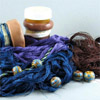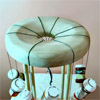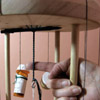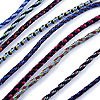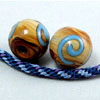- sale
- new items
- lovely beads
- wedding beads
- beads for teens
- for custom order
- newsletter
- recognition
- testimonials
- birthstones
- zodiac signs
- jewelry guide
SHOP BAG
![]() in your bag 0 items
in your bag 0 items
Kumihimo literally means "bringing together" or "the gathering of threads".
Braiding is part of being human. We have a need to adorn ourselves and what we use in our everyday lives. Beads are thousands of years old. Braids aren't quite that old. Only fragments of ancient textiles exist now because fibers tend disintegrate. But those fragments have been carbon-dated to around 8000BCE (before common era). In Peru braids were used for slings. (A sling is used to throw stones, as in hunting. David killed Goliath by throwing that fatal rock with a sling. David wasn't in Peru, of course, but braids evolved independently to each other on different continents. Part of that human thing again, common needs lead to common solutions.)
In Japan as well, there are very few primitive textile remnants because the humid climate there tends to rot fibers away. But there are traces of braids that date back to between 8000 to 400BCE when someone had the wonderful idea to press "twisted ropes" into wet clay pots before firing. We have those pot fragments today. Braids have also been found in burial mounds of the wealthy and powerful. In the mid 500's when Buddhism was brought to Japan from Korea it came with braids for religious ceremonies. But after that period, where braids were made is still a mystery. "They could have come from Korea and China or made in Japan." (quote from Mr. Owen's book "250 Braids from Peru, Japan & Beyond" and the source of most of the history in this article). Braids for religious use were made by skilled craftsmen (some braiders still keep some braiding secrets to themselves). Every day braiding techniques were passed down orally, as many crafts were. In the mid 600's different colors were imported from China: lilac, purple, blue, green, gold, and Chinese orange. These were "lucky" colors, a tradition that continues even in modern Japan.
Besides religious use where else were braids used? Samurai used flat braids to tie their plate armor pieces together. In times of peace braids became part of the Japanese tea ceremony as covers for the pots, cups, and saucers; they decorated clothing, scrolls, and homes.
The round braid appeared sometime between 1573-1614, during the Monoyama period. (Periods were determined by the names of ruling emperors or powerful families.) There are different looms for braids but I will concentrate on the "maru dai" which was probably used to make the round braids for religious ceremonies (sometime between 784-1184).
The maru dai is the round stand or braiding stool. The top is flat, round, and has a hole in the center. It's made of close-grained wood and not finished with paints or varnishes. They would make the top, the "mirror", too slippery, threads would slip out of position and be hard to control. The height of the stand is determined by the physical condition of the braider. Usually, the person kneels on a pillow or cushion on the floor to braid. (I put mine on a TV tray since I can't kneel for any length of time. Standing is much more comfortable.)
What can be braided? Just about anything that can be. I use silk, which is the traditional fiber although a synthetic silk, Biron, is available and less expensive. There are several suppliers of kumihimo equipment and silk (I buy from www.braidershand.com) Silk can come in different packaging; the silk I use comes in a "bundle" of four "ropes", 105 inches long with 42 threads per rope. Tradition says the obijama (a braid tied over an obi that wraps around a kimono) must be a regular thickness and the same thickness (about 1/4 inch or so) along its entire length. It uses 672 threads so a braider need only combine ropes to get the right number. I prefer to braid jewelry so I need less threads, fortunately. For anyone who has tried to untangle yarn or sewing thread: silk can be just as bad or worse. I lay a rope across my lap (using a white towel underneath to see the threads better). I now have forty-two 105" long threads in my lap and only need some of them. With the end of the rope on my left, and the knot on my right I can start picking out threads. I must pull each thread out from all the others, following that thread through all the way to the end of the rope. Then I take that thread and cut it to twice the finished length of the necklace. I cut the same number of threads for each bobbin. Important fact: you need to know the finished length of the necklace because the "take up" can use (take up) half the length of your threads.
Thread is wound around bobbins, or "tama", that resemble small dumb-bells. They come in different weights. Weight is an extremely important part of braiding: it keeps tension on the silk threads and the braid. A counterbalance, usually a bag that holds another weight, is attached to the braid below the top of the maru dai, and pulls the braid down through the opening. Important fact: if you somehow lose the counterbalance while braiding the bobbins will fly up and away! (I know this from experience, and it only happens once before you learn). To prevent this a chopstick is placed up against the bottom side of the mirror to hold the strands down when the piece is left overnight or the weight of the counterbalance would mark the braid. Typically, for an eight bobbin braid, the weight is about 45% of the total weight. If you use more weight the braid has a looser structure, less weight and the braid is dense and stiffer. Thank goodness for calculators!
Now, time to decide which type of braid to make: an eight bobbin braid, the "kongo" braid. This is the popular spiral braid you see so often. I wind my bobbins, tie the loose ends together and put the knotted end down through the hole in the mirror and attach the counterbalance. This is called "dressing the maru dai", or "governing the spirit of the thread". To make the "kongo" braid the strands of silk must lie at the four points of the compass: north, east, south, and west. I will continually adjust the strands, keeping them in position. In fact, you could make only spiral braids your entire career: just change colors, fibers, textures, add beads, and you will never have any two the same!
Some braiders consider kumihimo very peaceful. The movements are rhythmic, almost hypnotic, repeating again and again. But, you must never lose your place. And here's another important fact: the right and left hands don't usually have equal strength. You must learn to pay attention to how high you lift the threads as you braid. The way you lift the threads can affect the braid's appearance.
There are many different methods of finishing braids, such as tassells, loops, metal end caps, beaded end caps; you are limited only by your imagination.
To see some examples of kumihimo jewelry, visit my small gallery here or check out www.braidershand.com, Jacqui Carey, or Rodrick Owen. Or just google kumihimo and prepare to be amazed.
My gallery on MyLovelyBeads.com
About author:
| Susan Daigle, Oakland, Maine, USA | |
| Email address: | sedaigle@roadrunner.com |
| Etsy shop: | BeadsOnHand Etsy Shop |
| Blog: | www.beadsonhand.blogspot.com |


